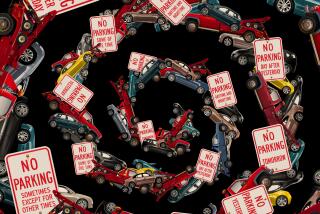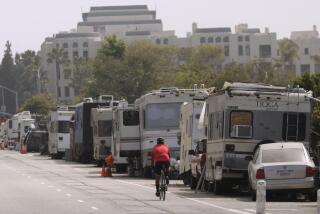L.A. Hoping to Put Dent in Derelict-Car Problem
The Volkswagen parked at the curb just a block from the Sylmar house where Debbie White Morales has lived most of her life hadn’t moved in more than a month. That is, it hadn’t moved in one piece.
Part by part, the vehicle was stripped by scavengers. A door was taken, then the wheels. They got the engine and hood, the seats, the steering wheel and the sun roof. Now even the glove-compartment door is gone. The car, what is left of it, was an eyesore that Morales saw every day.
Morales, 28, said she first called Los Angeles parking enforcement officers in early December to get the Volkswagen and a half-dozen other abandoned vehicles towed out of her neighborhood along San Fernando Road. Results were slow. The Volkswagen was finally removed last week. Another car, an old Chevrolet Nova on Paddock Street with no front wheels, was also towed. That took about three weeks.
‘Very Frustrating’
But since then, Morales has noticed that another car--a front tire flat, the hood sprung--has been abandoned nearby. And, still, there are the others she first called about: a rusting Hornet station wagon across Paddock from her home, and an old Plymouth on San Fernando Road with a fender missing and a door swung open.
“They are all over the neighborhood,” she said. “They make the place look very trashy and, when you finally get the city to tow one out of here, somebody else will just leave another one. It’s very frustrating. People think the neighborhood doesn’t care.”
Morales is not alone in her frustration. Everyone who deals with abandoned vehicles in the San Fernando Valley is frustrated: police and politicians, parking enforcement officers and even tow-truck operators.
The City of Los Angeles tows about 25,000 abandoned cars off its streets each year, more than one-third of them in the Valley. In November, for example, 825 of 2,281 abandoned cars towed were in the Valley. Officials said one-third of the 75 parking enforcement officers in the Valley respond only to abandoned-car complaints.
‘Endless Supply’
“Sometimes I think the only reason we tow an abandoned car away is to clear a space for the next one,” said Candice Vail, a parking enforcement supervisor in the Valley.
“There seems to be an endless supply of these cars,” lamented City Councilman Ernani Bernardi, whose northeast Valley district includes areas where there have been many abandoned autos.
The sheer glut of abandoned cars in the Valley, coupled with a large number of unfounded complaints--about 80% of the cars reported abandoned actually have not been--often make removal slow, city officials say. Cars abandoned on the streets can spend weeks there, contributing to neighborhood decay, authorities say.
A 1987 city task force deployed new procedures, including the periodic use of squads of tow trucks to sweep whole areas of abandoned vehicles. But, officials concede, the problem remains.
“I would like to say it is better, but I don’t think it is,” said Greg Jackson, an aide to Bernardi. He said he routinely reports complaints from residents about abandoned cars to parking enforcement officers, only to see it sometimes take weeks for the cars to be removed.
“We have seen a lot of effort, but it seems like we still have the problems,” he said. “The sweeps are only a temporary dent. We recently did a sweep in which we picked up 126 abandoned autos on a Saturday. The next Monday, I came across 26 cars in one hour.”
But officials are buoyed somewhat because more changes are on the way. State legislation that went into effect Friday will help streamline removal of the abandoned shells of cars such as those near Morales’ home. Rather than going through a four-day process of ticketing a car, waiting for an owner to move it and then waiting for a tow truck, officers will be able to call for immediate towing of obviously abandoned cars--those that are inoperable--or of cars that pose a hazard. Parking officers also will not have to be present when the tow trucks come.
‘One-Step Process’
“It will become a one-step process in getting an eyesore off the street,” said Robert Yates, parking administrator for the city.
Most abandoned cars, Yates said, are not discarded by thieves, but by owners who don’t want to bother taking them to junkyards. In an effort to discourage that, Los Angeles will take care of having cars towed away and disposed of at no cost to owners.
“Before, people were just dumping their cars on the street,” Yates said. “Now, if somebody wants to get rid of his car and has clear title to it, they will be able to call the city and we’ll take care of it.”
Yates said the city also hopes early this year to implement a toll-free telephone number and a computerized system for reporting the locations of abandoned cars. The efforts are primarily designed to free parking officers so that more abandoned cars can be removed more quickly.
Although the efforts may be welcomed by residents, police and politicians, they do not eliminate the frustrations of the 16 garages that contract with the city to do all police towing.
Alan Shepard, Official Police Garages Assn. president, said the garages make money by towing cars that owners want back and will pay impound and towing fees for, and by towing cars that can be sold at a profit over towing costs if never claimed.
Money-Losers
He said that most abandoned cars are money-losers because they already have been picked clean of useful parts by scavengers and that the cost of towing and storing them is rarely recovered.
“But you really can’t blame them,” said Vail, the parking enforcement supervisor.
Some city officials complain that the worst eyesores among the abandoned hulks are the hardest to get towed.
Capt. Arthur Sjoquist, commander of the Police Department’s Foothill Division, said civilian and police complaints about abandoned hulks often are not enough to set the removal process in motion.
“We’ve found that sometimes it takes calls from a city councilman’s office,” he said.
However, Shepard and Vail said, several factors weigh in how quickly cars are towed.
‘We Can Barely Keep Up.’
“You run out of hours in the day with all the tow-away calls we get,” Vail said. “We can barely keep up.”
“We can’t pick and choose the cars we tow,” impound-yard spokesman Shepard said. “You take the bad car along with the good car. When the city calls up and says, ‘Go get that car,’ we can’t tell them we aren’t going to go.”
In the Valley, officials said, the Foothill Division’s jurisdiction has become a dumping ground for abandoned and stolen cars. People tend to leave their cars near the several junkyards in the area, authorities said. The area also contains low- and middle-income neighborhoods whose streets are prime drop-off spots for junked and stolen cars. About twice as many stolen cars are recovered in the division’s jurisdiction as are reported stolen from that area, officials said.
Abandoned cars are more than just eyesores, Sjoquist said. There is a popularly held law-enforcement philosophy called the “broken window” theory: If a window in a home or business is broken and goes unrepaired, it won’t be long before the remaining windows are broken by vandals who think that nobody cares. Sjoquist said an abandoned car is a neighborhood’s broken window.
The result, he said, can be an escalation of property crimes and the decline of a neighborhood.
Morales said she cares about her neighborhood. That is why she and other members of her family frequently cruise its streets and report abandoned vehicles that they see.
Fatal Shooting
It is a new routine for her, begun Dec. 3 after her stepfather was shot to death in a robbery attempt down the street from their home on Paddock Street. The shooting occurred when a gunman drove a van from behind an abandoned car and blocked Albert Morales’ car as he was heading home.
In the days after the killing, the abandoned car--the Nova with two wheels missing and its front end jutting into the street--served as a constant reminder to Debbie Morales of what had happened.
She said she lost track of how many times she or her sisters or brothers called the city to ask that the Nova and other abandoned cars in the neighborhood be removed. They repeatedly enlisted the help of aides to Bernardi. Two days before Christmas--almost three weeks after she began calling--the car was towed away.
“I don’t think four calls from a councilman’s office and who knows how many from the community to get one car moved is acceptable,” said Bernardi aide Jackson. “It shows the kind of problem we have.”
But late last week, what’s left of the abandoned Hornet and Plymouth were still in Debbie Morales’ neighborhood.
More to Read
Sign up for Essential California
The most important California stories and recommendations in your inbox every morning.
You may occasionally receive promotional content from the Los Angeles Times.










